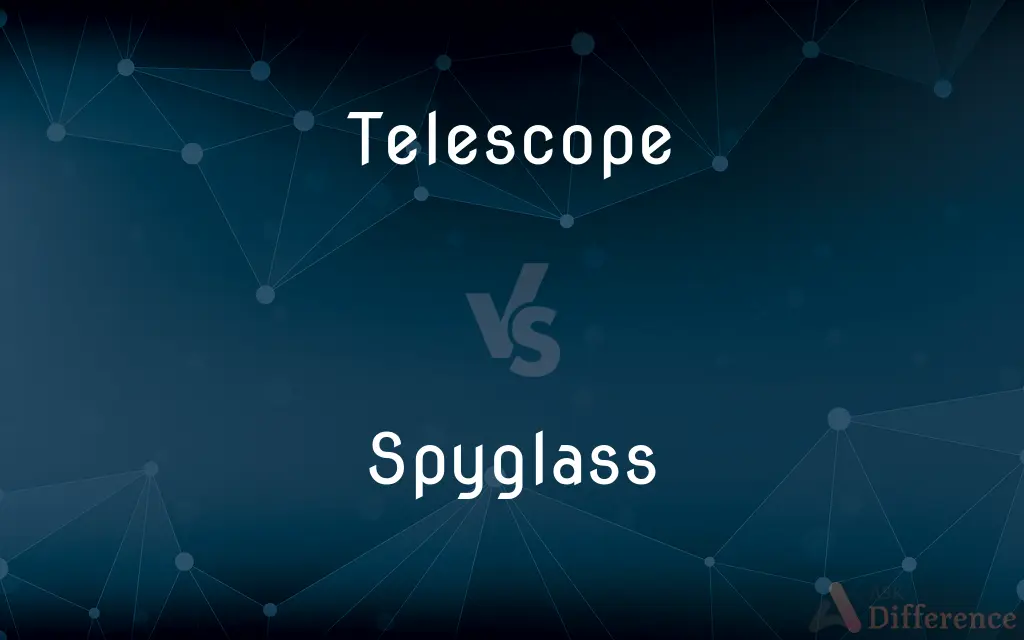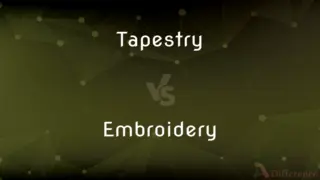Telescope vs. Spyglass — What's the Difference?
By Maham Liaqat & Fiza Rafique — Updated on April 15, 2024
A telescope is a complex optical instrument designed for detailed observation of distant celestial bodies, while a spyglass, a type of telescope, is simpler and primarily used for terrestrial viewing, such as in navigation or surveillance.

Difference Between Telescope and Spyglass
Table of Contents
ADVERTISEMENT
Key Differences
Telescopes are designed with sophisticated optics, including multiple lenses or mirrors, to enhance the observation of distant objects like stars, planets, and galaxies. These instruments can be large and often require mounts and other stabilizing equipment. In contrast, a spyglass, traditionally known as a monocular or handheld telescope, uses a simpler arrangement of lenses and is designed for one-handed use, making it highly portable and convenient for terrestrial observations.
The primary function of telescopes is astronomical observation, enabling detailed studies of celestial phenomena and contributing to advancements in astrophysics and cosmology. On the other hand, spyglasses have historically been used by sailors, pirates, and explorers for navigation and observation at sea, offering a quick and easy way to survey distant objects on the horizon.
Modern telescopes are equipped with technology such as computerized tracking systems, cameras, and specialized filters that enhance their functionality for scientific research and detailed space observation. Meanwhile, spyglasses remain relatively unchanged in their basic design, prioritizing portability and ease of use over advanced technological enhancements.
Telescopes can be found in various types, including refracting, reflecting, and compound telescopes, each suited to different observational needs based on their optical designs. Conversely, spyglasses are generally simple refractors with a limited range of magnification, focusing on providing clear and immediate views at lower magnification levels.
While telescopes are typically used in permanent installations like observatories or as sophisticated amateur setups for stargazing, spyglasses are more commonly seen in historical reenactments, maritime contexts, and as collectible items or practical tools for hikers and birdwatchers who need a quick and compact viewing device.
ADVERTISEMENT
Comparison Chart
Design Complexity
Multiple lenses or mirrors, often large and complex
Single or few lenses, compact and handheld
Primary Use
Astronomical observation
Terrestrial viewing, navigation
Technological Features
Equipped with tracking systems, cameras, filters
Simple, without technological enhancements
Types
Refracting, reflecting, compound
Generally simple refractors
Typical Users
Astronomers, scientists, hobbyists
Sailors, explorers, hikers, birdwatchers
Compare with Definitions
Telescope
Computerized tracking.
Advanced telescopes often include computerized systems to track celestial objects.
Spyglass
Monocular.
As a compact monocular, the spyglass is easy to carry and use with one hand.
Telescope
Scientific research.
Telescopes contribute to our understanding of the universe through detailed celestial observations.
Spyglass
Navigational aid.
Explorers historically relied on spyglasses for land and sea navigation.
Telescope
Stargazing tool.
Amateur astronomers use telescopes to explore the night sky from their backyards.
Spyglass
Historical artifact.
Spyglasses are often seen as iconic tools in stories of piracy and maritime adventure.
Telescope
Astronomical device.
The telescope at the observatory allows astronomers to study distant galaxies.
Spyglass
Portable viewer.
The captain used his spyglass to spot ships on the horizon.
Telescope
Reflecting optics.
Many modern telescopes use mirrors to focus light and form images.
Spyglass
Simple design.
The spyglass consists of a straightforward lens system within a collapsible tube.
Telescope
A telescope is an optical instrument using lenses, curved mirrors, or a combination of both to observe distant objects, or various devices used to observe distant objects by their emission, absorption, or reflection of electromagnetic radiation. The first known practical telescopes were refracting telescopes invented in the Netherlands at the beginning of the 17th century, by using glass lenses.
Spyglass
A small telescope.
Telescope
An arrangement of lenses or mirrors or both that gathers light, permitting direct observation or photographic recording of distant objects.
Spyglass
Often spyglasses A pair of binoculars.
Telescope
Any of various devices, such as a radio telescope, used to detect and observe distant objects by their emission, absorption, or reflection of electromagnetic radiation.
Spyglass
A small portable telescope.
Telescope
To cause to slide inward or outward in overlapping sections, as the cylindrical sections of a small hand telescope do.
Spyglass
A pair of binoculars.
Telescope
To make more compact or concise; condense.
Spyglass
A small telescope for viewing distant terrestrial objects.
Telescope
To slide inward or outward in or as if in overlapping cylindrical sections
A camp bucket that telescopes into a disk.
Spyglass
A small refracting telescope
Telescope
A monocular optical instrument that magnifies distant objects, especially in astronomy.
Telescope
Any instrument used in astronomy for observing distant objects (such as a radio telescope).
Telescope
(television) A retractable tubular support for lights.
Telescope
(ambitransitive) To extend or contract in the manner of a telescope.
Telescope
(ambitransitive) To slide or pass one within another, after the manner of the sections of a small telescope or spyglass.
Telescope
(intransitive) To come into collision, as railway cars, in such a manner that one runs into another.
Telescope
To collapse, via cancellation.
Telescope
An optical instrument used in viewing distant objects, as the heavenly bodies.
Telescope
To slide or pass one within another, after the manner of the sections of a small telescope or spyglass; to come into collision, as railway cars, in such a manner that one runs into another; to become compressed in the manner of a telescope, due to a collision or other force.
Telescope
To cause to come into collision, so as to telescope.
Telescope
To shorten or abridge significantly; as, to telescope a whole semester's lectures into one week.
Telescope
Capable of being extended or compacted, like a telescope, by the sliding of joints or parts one within the other; telescopic; as, a telescope bag; telescope table, etc.; - now more commonly replaced by the term telescoping.
Telescope
A magnifier of images of distant objects
Telescope
Crush together or collapse;
In the accident, the cars telescoped
My hiking sticks telescope and can be put into the backpack
Telescope
Make smaller or shorter;
The novel was telescoped into a short play
Common Curiosities
Are spyglasses still used today?
Yes, spyglasses are still used for various practical purposes like hiking and birdwatching, and they are popular among collectors and historical reenactors.
Why are telescopes not portable like spyglasses?
Telescopes often contain sophisticated and delicate optical components that require stable mounts and alignments, making them less portable than the rugged, handheld design of spyglasses.
How did historical figures use spyglasses?
Historical figures, especially in maritime contexts, used spyglasses for navigation and spotting distant objects such as ships or land.
What is the main difference between a telescope and a spyglass?
The main difference is in their complexity and use: telescopes are complex and used for space observation, while spyglasses are simple and used for viewing terrestrial objects.
Can a spyglass be used for stargazing?
While it's possible, a spyglass is not ideal for stargazing due to its limited magnification and simpler optics compared to specialized astronomical telescopes.
How do the optics of a telescope and a spyglass differ?
Telescopes may use a combination of lenses and mirrors to achieve higher magnification and clearer images, while spyglasses typically use only lenses.
What type of telescope is best for beginners?
Refracting telescopes are often recommended for beginners due to their simple design and ease of use.
What innovations have been made in telescope technology?
Innovations include adaptive optics, digital imaging, and automated tracking systems that improve observation accuracy and convenience.
Can spyglasses magnify as much as telescopes?
No, spyglasses generally have lower magnification capabilities compared to telescopes, which are designed for observing much more distant objects.
What should one consider when choosing between a telescope and a spyglass?
Consider the primary purpose: detailed celestial observation or simple, quick terrestrial viewing.
Share Your Discovery

Previous Comparison
Location vs. Vicinity
Next Comparison
Tapestry vs. EmbroideryAuthor Spotlight
Written by
Maham LiaqatCo-written by
Fiza RafiqueFiza Rafique is a skilled content writer at AskDifference.com, where she meticulously refines and enhances written pieces. Drawing from her vast editorial expertise, Fiza ensures clarity, accuracy, and precision in every article. Passionate about language, she continually seeks to elevate the quality of content for readers worldwide.














































